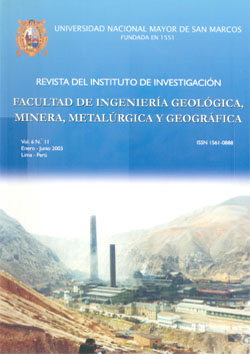Physicochemical and physiographic variability of the San Pedro-Vice mangrove ecosystem (Piura-Peru)
DOI:
https://doi.org/10.15381/iigeo.v6i11.517Keywords:
Swamp, structural dynamics, productivityAbstract
The San Pedro mangrove ecosystem (Vice-Piura) began its expansion from the "El Niño" event in 1983; It constitutes a refuge and reproduction area for aquatic organisms of commercial importance. Seasonal monitoring was performed, establishing 9 fixed stations (R1, R2, R3, M1, M2, M3, M4, M5 and M6), for the evaluation of physicochemical and physiographic parameters. High oxygen values (10.40-13.20 mg / lt). The electrical conductivity (8.89-14.22 mS), the nitrate concentration (> 0. 25 ppm) and the pH (8.0-8.1) reflect phytoplankton activity processes, qualifying the ecosystem as highly productive; the impact factor is the sedimentation of material carried from the upper river course that determines the physiographic characteristics for each environment. The sandy and sandy soil substrate associated with submerged vegetation in the river, silt, silty clay and sandy soil with organic matter in the mangrove, depends directly on the sedimentation processes, directly affecting the establishment of habitat for macroinvertebrates. This ecosystem presents high heterogeneity of habitat and spatio-temporal instability regarding its physicochemical and physiographic characteristics.
Downloads
Published
Issue
Section
License
Copyright (c) 2003 Walter Huaylinos Villalva, Eliana Quispitúpac Quispitúpac, Norberta Martínez Luján

This work is licensed under a Creative Commons Attribution-NonCommercial-ShareAlike 4.0 International License.
AUTHORS RETAIN THEIR RIGHTS:
a. Authors retain their trade mark rights and patent, and also on any process or procedure described in the article.
b. Authors retain their right to share, copy, distribute, perform and publicly communicate their article (eg, to place their article in an institutional repository or publish it in a book), with an acknowledgment of its initial publication in the Rev. Inst. investig. Fac. minas metal cienc. geogr.
c. Authors retain theirs right to make a subsequent publication of their work, to use the article or any part thereof (eg a compilation of his papers, lecture notes, thesis, or a book), always indicating the source of publication (the originator of the work, journal, volume, number and date).






